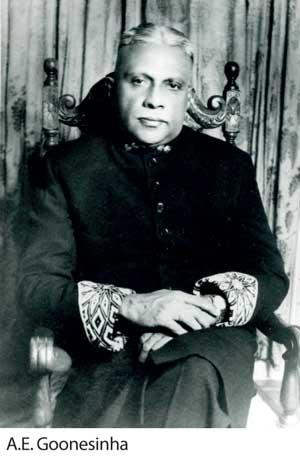10 Oct 2022 - {{hitsCtrl.values.hits}}
 The Ceylon Labour Union, which celebrates its centenary anniversary in September this year 2022, was an organization formed during the height of British imperialism in Sri Lanka. Its founder was the pioneer Labour leader Mr. A.E. Goonesinha (1891-1967). To quote from his autobiography:
The Ceylon Labour Union, which celebrates its centenary anniversary in September this year 2022, was an organization formed during the height of British imperialism in Sri Lanka. Its founder was the pioneer Labour leader Mr. A.E. Goonesinha (1891-1967). To quote from his autobiography:
“In September 1922, a meeting was held at the Elphinstone theatre presided over by the late Mr. E.R. Thambimuttu (MLC) and the Ceylon Labour union was formed. Though the hall was full, the enrolment of members amounted to only 25. Mr. C.E. Viktor Corea was elected president and I was elected Secretary but a few months later I had to take over the president’s post. We began holding propaganda meetings in the city and in the outstations. By these means the Labour class was thoroughly awakened to the consciousness of their rights as workers. My activities were not the results of book education but of empirical knowledge. The ‘Pothe Gurus’ (book pundits) delving deeply into the books of Karl Marx and others on socialism etc. came at a later date”.
 It was a time when the word ‘Labour union’ was unheard of. There were several strikes like the printer’s strike 1896 and the carter’s strike in 1906 but even by the end of the second decade of the 20th century, there was no organized Labour movement in Ceylon. Employers exploited the workers as they wished and the government was not concerned. Workers were not paid properly; there was no proper leave system or accident compensation. Mr. A.E. Goonesinha had first-hand experience of the plight of the workers as he was engaged in welfare work in the city. By early 1920s, he was a well-known anti-imperialist as well and he had served a jail sentence in 1915. His triumph in the campaign against the Poll-tax had shaken the colonial government. His emergence as a Labour leader was not to their satisfaction. Employers were concerned with the organization of the working class and they refused to recognize the unions. His autobiography mentions several such episodes. However, one British employer, Mr. S.P. Hayley, had a sympathetic ear towards workers demands and came to an agreement with the union.
It was a time when the word ‘Labour union’ was unheard of. There were several strikes like the printer’s strike 1896 and the carter’s strike in 1906 but even by the end of the second decade of the 20th century, there was no organized Labour movement in Ceylon. Employers exploited the workers as they wished and the government was not concerned. Workers were not paid properly; there was no proper leave system or accident compensation. Mr. A.E. Goonesinha had first-hand experience of the plight of the workers as he was engaged in welfare work in the city. By early 1920s, he was a well-known anti-imperialist as well and he had served a jail sentence in 1915. His triumph in the campaign against the Poll-tax had shaken the colonial government. His emergence as a Labour leader was not to their satisfaction. Employers were concerned with the organization of the working class and they refused to recognize the unions. His autobiography mentions several such episodes. However, one British employer, Mr. S.P. Hayley, had a sympathetic ear towards workers demands and came to an agreement with the union.
After some time Mr. Goonesinha’s request to appoint a railway commission was submitted to the legislative council by Mr. C.H.Z. Fernando, another member of the union. Subsequently a commission was appointed with Mr. H.W. Codrinton as the chairman and it awarded many benefits to the workers
Under any colonial regime indigenous people not only lose their self-respect but they are not treated properly. One can only imagine the plight of the workers who formed the lower strata of the society in such a situation. Mr. Goonesinha saw this situation as he was actively engaged in social services. Both his human kindness and anti-imperialist nature prompted him to help the downtrodden masses.
General strike of 1923
After forming the Labour union in 1922 there was a general strike in 1923. It started from the railways and spread into many other government institutions like government workshops and harbour. More than twenty thousand people joined. Apparently, our own local leaders sabotaged it. Mr. Goonesinha comments in his autobiography:
“The general strike of 1923 was not the success I wanted it to be. We had no funds. I had to beg all round to keep twenty thousand going. ‘The local leaders’ were against us. They had already sided with the government during the riots of 1915. In this struggle there was only one man who sympathized and helped us and that was the great patriot Anagarika Dharmapala. Though we had called off the strike on the basis of Manning’s promise nothing was done for two years about appointing a commission”.
After some time Mr. Goonesinha’s request to appoint a railway commission was submitted to the legislative council by Mr. C.H.Z. Fernando, another member of the union. Subsequently a commission was appointed with Mr. H.W. Codrinton as the chairman and it awarded many benefits to the workers like a 20 % salary increase, five days leave, sick leave, casual leave, etc.
A number of strikes took place in the subsequent years, the most remarkable being the tramway strike of 1929.
This is a comment from his Autobiography:
“One of the most spectacular and sensational events in the history of the Island was the tramway strike of 1929. Spectacular because of the advent of about thirty-five Europeans who began driving tram cars in the streets of Colombo. Sensational because of the many events that transpired during the course of the strike. All the tramway men who had joined the union made representations to me in respect of their conditions of service (In the matter of wages, meal hours, rain coats, etc.). I addressed a letter mentioning all these facts to Mr. Cedric Boustead, managing director of Messrs. Boustead limited, the proprietors of the Colombo tramway service. A week passed but there was no reply forthcoming. A reminder was sent to which he replied immediately stating that he recognized no trade union and he would deal with the men who had joined the union. This was a direct challenge to trade unionism and no self-respecting trade unionist could take it lying down. I instantly called a meeting of all the tramway men, drivers, conductors, workshop men etc. Virtually 100 % of the men were present. And it was unanimously resolved that all would participate in the tramway strike the following day”.
Under any colonial regime indigenous people not only lose their self-respect but they are not treated properly. One can only imagine the plight of the workers who formed the lower strata of the society in such a situation. Mr. Goonesinha saw this situation as he was actively engaged in social services. Both his human kindness and anti-imperialist nature prompted him to help the downtrodden masses
The tramway strike continued for seven days and during this time Mr. Goonesinha had arranged private transport for the commuters. Tram cars ran empty in the midst of jeers of the on-lookers. Finally, a settlement was reached, but on that day the police went on a rampage. A rumor spread that Mr. Goonesinha was shot and people rioted. They stopped the passing vehicles, drew petrol and set fire to the Maradana police station. A fire brigade was set on fire at the Maradana bridge and five people were shot dead by the police. Dr. Kumari Jayawardane states “the strike which had started as an industrial dispute for wages ended in the popular uprising of violent resistance to authorities. The original cause of the strike was forgotten and the Colombo workers came out to the street to show their support for Goonesinha and to manifest their defiance of the police”, page 291, The Rise of the Labour Movement in Ceylon. Mr. Goonesinha colLabourated with the leaders of the British Labour party when Mr. Josiah Wedgewood came to Ceylon in 1921. He gave him a public reception. Then Mr. Ramsey Mcdonald became Prime Minister in 1926 and again the Ceylon Labour Union arranged a mammoth reception. His friendship with the British Labour parliamentarians helped in the negotiations of adult franchise. Dr. Drummond Shields, who was a member of the Donoughmore commission, helped substantially in the achievement of the franchise. Mr. Goonesinha and Mr. George. E. De Silva attended a British Labour Party conference in London 1927 and on return, the Ceylon Labour Party was formed in 1928. For the first time in history, May Day was celebrated in Sri Lanka on 1st May (coincidentially also A.E. Goonesinha’s birthday) in 1931.
Benefits enjoyed by the present-day workers are largely due to the efforts of the Ceylon Labour Union. Dr. Kumari Jayawardane’s “The Rise of the Labour Movement in Ceylon” gives a vivid account of the contributions made by the Ceylon Labour Union for the upliftment of the working class of this country.
The writer is also the author of forthcoming book “ A.E. Goonesinha - CHARITHAPADANAYA” (Biography of Alexander Ekanayake Goonesinha)
25 Nov 2024 19 minute ago
25 Nov 2024 1 hours ago
25 Nov 2024 1 hours ago
25 Nov 2024 3 hours ago
25 Nov 2024 3 hours ago